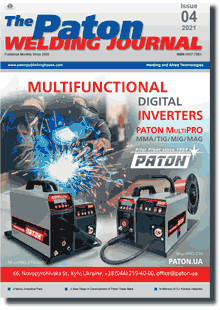| 2021 №04 (07) |
DOI of Article 10.37434/tpwj2021.04.01 |
2021 №04 (02) |

The Paton Welding Journal, 2021, #4, 2-8 pages
Physico-mechanical properties of welded joints of high-strength steel with the yield strength of 690‒1300 MPa
O.M. Berdnikova
E.O. Paton Electric Welding Institute of the NASU. 11 Kazymyr Malevych Str., 03150, Kyiv, Ukraine. E-mail: office@paton.kiev.ua
Abstract
The work is devoted to determination of regularities of influence of features of structural-phase composition (grain, subgrain, dislocation structures, etc.) of metal of welded joints of high-strength steels of different strength class on their mechanical characteristics and crack resistance by determining structural criteria providing the necessary set of these properties. The structure and properties of welded joints of high-strength steels with the yield strength from 690 to 1300 MPa was investigated depending on the rates of cooling and welding, welds alloying, heat treatment conditions and welding methods (mechanized arc, laser, hybrid laser-arc welding): structural low-carbon steels of bainitic-ferritic and bainitic-martensitic type; high-carbon ferritic-pearlitic type; alloy medium-carbon steels of martensitic-bainitic type of a special purpose. The correlation between structural parameters and such a set of properties as strength, fracture toughness, level of localized deformation and local inner stresses in the metal of welded joints was established. It was shown that in compliance with certain ratios of structural-phase components, the characteristics of dislocation and subgrain structure are decisive for providing strength and crack resistance of welded joint metal of high-strength steels. The indices of the level of localized deformation in the metal of welded joints of high-strength steels were obtained and it was found how structural components affect crack resistance of the metal. In order to provide the service reliability of structures in the creation of science-intensive and promising technologies for welding of high-strength steels on the basis of material experimental and theoretical studies, structural criteria were determined to provide the required set of mechanical properties and crack resistance of the mentioned joints. 12 Ref., 4 Figures.
Keywords: high-strength steels, welded joints, structural-phase composition, substructure, dislocation density, mechanical properties, local inner stresses, localized deformation, crack resistance
Received 23.02.2021
References
1. Paton, B.E. (2008) Selected proceedings. Kiev, PWI [in Russian].2. (2018) Science of materials, achievements, prospects. Ed. by L.M. Lobanov. Kyiv, Akademperiodyka, Vol. 2 [in Ukrainian].
3. Poznyakov V.D. (2017) Welding technologies for production and repair of metal structures from high-strength steels. Bulletin of the National Academy of Sciences of Ukraine, 1, 65-73.
4. (2018) Physical processes in welding and processing of materials. Theoretical investigation, mathematical modeling, computational experiment. In: Coll. of articles and reports. Ed. by I.V. Krivtsun. Kiev, IAW. ISBN 978-617-7015-74-0 [in Russian].
5. Madej, K., Świdergoł, S., Jakubiec, P. (2015) Analysis of Cracks in Welded Joints of Pipes with Eyes made of S890QL1 Steel. Biuletyn Instytutu Spawalnictwa, 6, 11−22. https://doi.org/10.17729/ebis.2015.6/2
6. Laukhin, D., Pozniakov, V., Beketov, O. et al. (2020) Analysis of the effects of welding conditions on the formation of the structure of welded joints of low-carbon low-alloy steels. Engineering Materials, 844, 146−154. https://doi.org/10.4028/www.scientific.net/KEM.844.146
7. Ostash, О.P., Kulyk, V.V., Poznyakov, V.D. et al. (2019) Influence of the Modes of Heat Treatment on the Strength and Cyclic Crack-Growth Resistance of 65G Steel. Mater Sci., 54(6), 776−782. https://doi.org/10.1007/s11003-019-00263-6
8. Kostin, V.A., Grigorenko, G.M., Poznyakov, V.D. et al. (2020) Structural Transformations of the Metal of Heat- Affected Zone of Welded Joints of High-Strength Armor Steels. Ibid, 55(6), 863−869. https://doi.org/10.1007/s11003-020-00380-7
9. Markashova, L., Berdnikova, O., Alekseienko, T. et al. (2019) Nanostructures in Welded Joints and Their Interconnection with Operation Properties. Advances in Thin Films, Nanostructured Materials, and Coatings. A.D. Pogrebnjak, V. Novosad (Eds.). Singapore, Springer, pp. 119−128. https://doi.org/10.1007/978-981-13-6133-3_12
10. Vimalraj C., Kah P., Layus P. et al. (2019) High-strength steel S960QC welded with rare earth nanoparticle coated filler wire. The International Journal of Advanced Manufacturing Technology, 102, 105-119. https://doi.org/10.1007/s00170-018-3059-6
11. Francois Njock Bayock, Kah, P., Layus, P., Karkhin, V. (2019) Numerical and Experimental Investigation of the Heat Input Effect on the Mechanical Properties and Microstructure of Dissimilar Weld Joints of 690-MPa QT and TMCP Steel. Metals, 9(3), 355, 1−19. https://doi.org/10.3390/met9030355
12. Berdnikova, O.M. (2020) Structural criteria of strength and crack resistance of high-strength steel welded joints. In: Syn. of Thesis for Dr. of Tech. Sci. Degree. Kyiv, PWI [in Ukrainian]
Suggested Citation
O.M. Berdnikova (2021) Physico-mechanical properties of welded joints of high-strength steel with the yield strength of 690‒1300 MPa. The Paton Welding J., 04, 2-8.The cost of subscription/purchase order journals or individual articles
| Journal/Currency | Annual Set | 1 issue printed |
1 issue |
one article |
| TPWJ/USD | 384 $ | 32 $ | 26 $ | 13 $ |
| TPWJ/EUR | 348 € | 29 € | 24 € | 12 € |
| TPWJ/UAH | 7200 UAH | 600 UAH | 600 UAH | 280 UAH |
| AS/UAH | 1800 UAH | 300 UAH | 300 UAH | 150 UAH |
| AS/USD | 192 $ | 32 $ | 26 $ | 13 $ |
| AS/EUR | 180 € | 30 € | 25 € | 12 € |
| SEM/UAH | 1200 UAH | 300 UAH | 300 UAH | 150 UAH |
| SEM/USD | 128 $ | 32 $ | 26 $ | 13 $ |
| SEM/EUR | 120 € | 30 € | 25 € | 12 € |
| TDNK/UAH | 1200 UAH | 300 UAH | 300 UAH | 150 UAH |
| TDNK/USD | 128 $ | 32 $ | 26 $ | 13 $ |
| TDNK/EUR | 120 € | 30 € | 25 € | 15 € |
AS = «Automatic Welding» - 6 issues per year;
TPWJ = «PATON WELDING JOURNAL» - 12 issues per year;
SEM = «Electrometallurgy Today» - 4 issues per year;
TDNK = «Technical Diagnostics and Non-Destructive Testing» - 4 issues per year.


